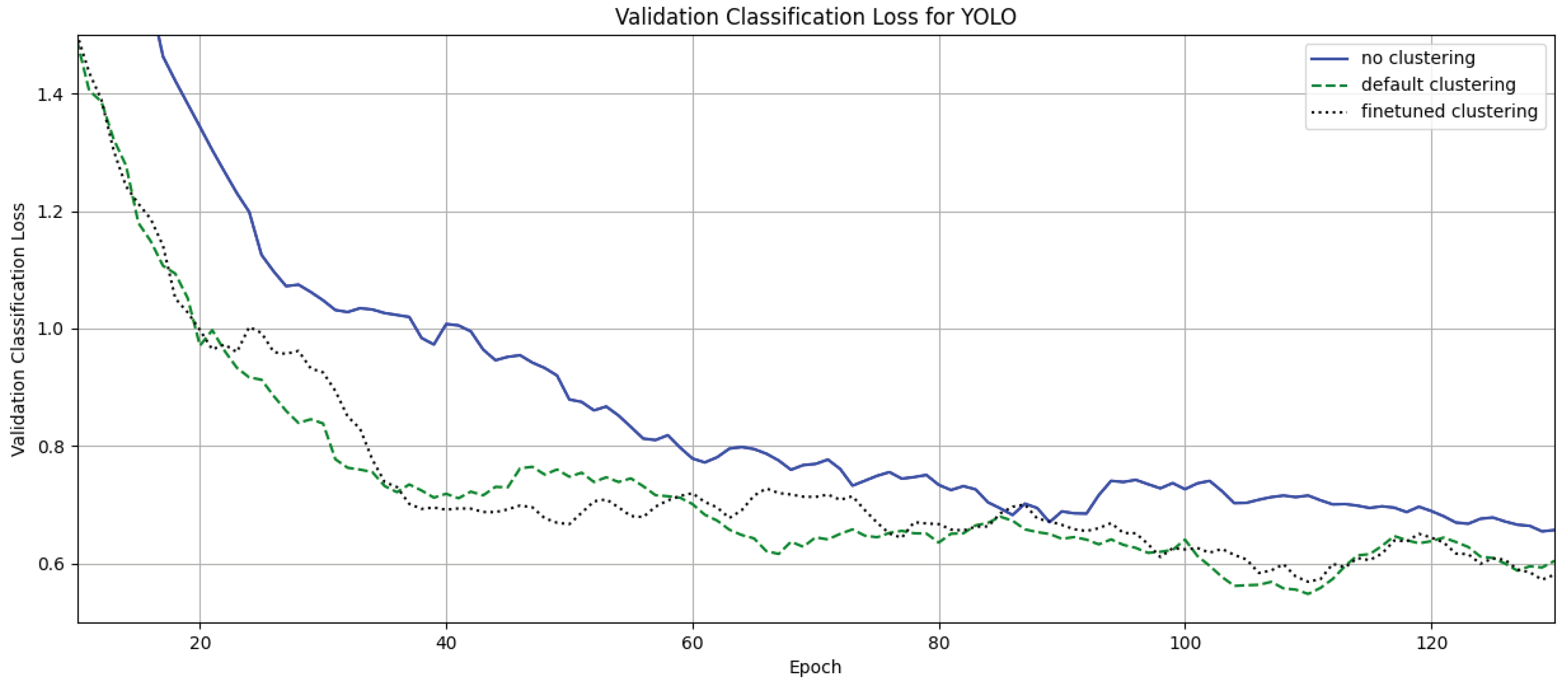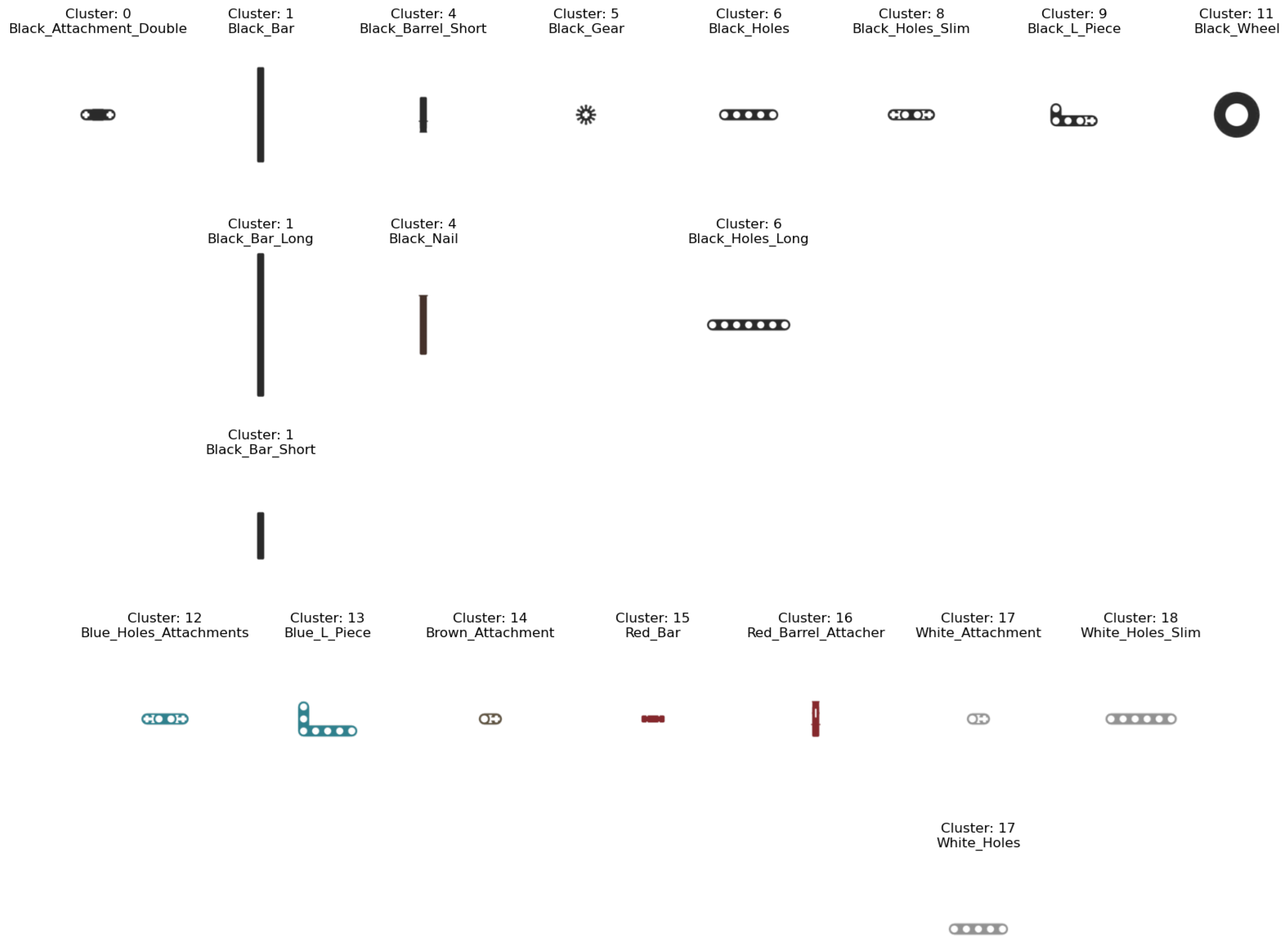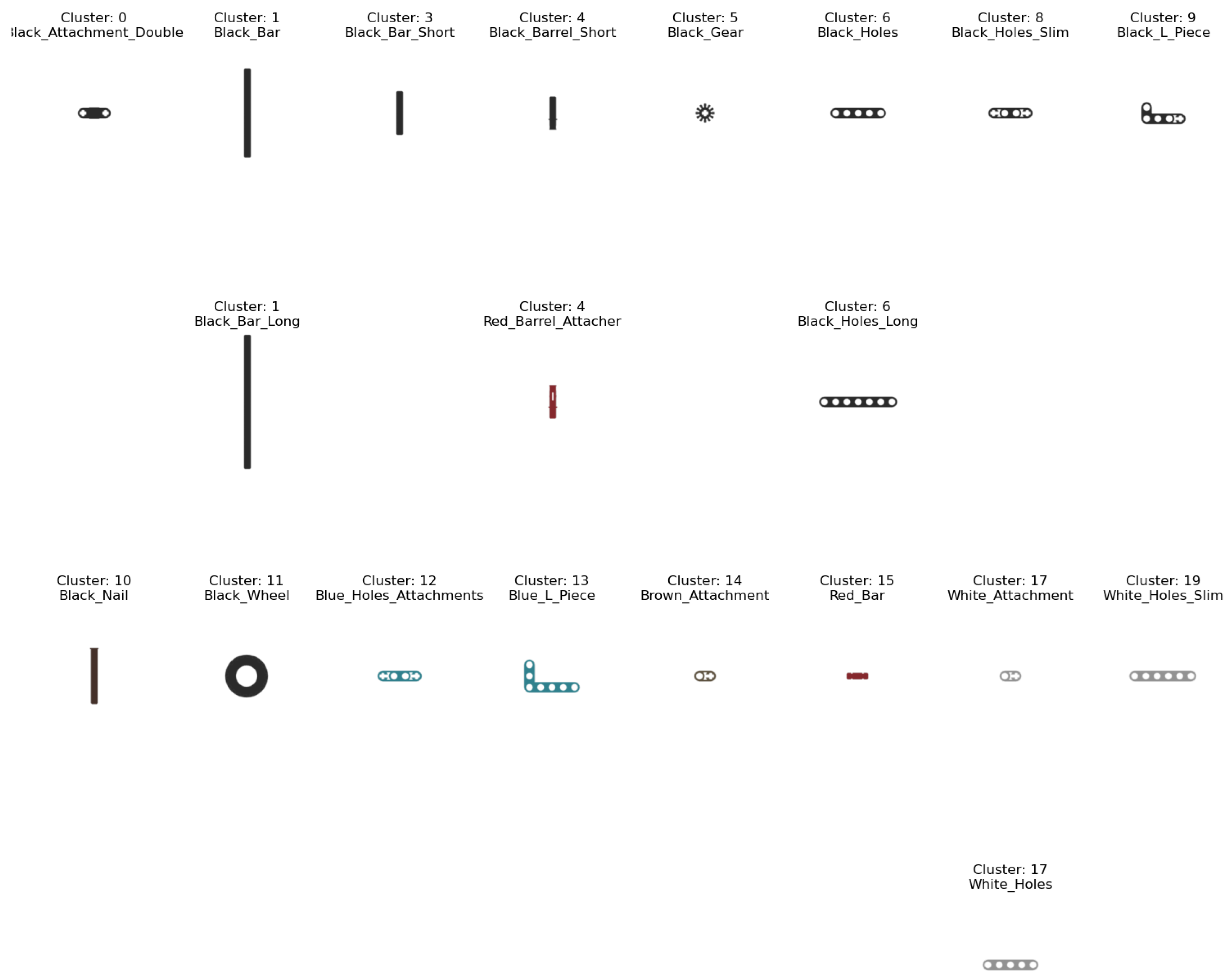Clustering Visual Similar Objects for Enhanced Synthetic Image Data for Object Detection
Abstract
:1. Introduction
2. Related Work
2.1. Industrial Object Detection
2.2. Synthetic Data for Object Detection
2.3. Object Similarity Analysis
3. Materials and Methods
3.1. Similarity Analysis
3.1.1. Pre-Processing
3.1.2. Clustering
3.1.3. Post-Processing
3.2. Fine-Tuning
3.3. Experimental Procedure
4. Results
4.1. Clustering Without Fine Tuning
4.2. Clustering with Fine-Tuning
5. Discussion
6. Conclusions
Author Contributions
Funding
Institutional Review Board Statement
Informed Consent Statement
Data Availability Statement
Conflicts of Interest
References
- Hussain, M. YOLO-v1 to YOLO-v8, the Rise of YOLO and Its Complementary Nature toward Digital Manufacturing and Industrial Defect Detection. Machines 2023, 11, 677. [Google Scholar] [CrossRef]
- Yun, H.; Kim, E.; Kim, D.M.; Park, H.W.; Jun, M.B.G. Machine Learning for Object Recognition in Manufacturing Applications. Int. J. Precis. Eng. Manuf. 2023, 24, 683–712. [Google Scholar] [CrossRef]
- Ahmad, H.M.; Rahimi, A. Deep learning methods for object detection in smart manufacturing: A survey. J. Manuf. Syst. 2022, 64, 181–196. [Google Scholar] [CrossRef]
- Riedel, A.; Gerlach, J.; Dietsch, M.; Herbst, S.; Engelmann, F.; Brehm, N.; Pfeifroth, T. A deep learning-based worker assistance system for error prevention: Case study in a real-world manual assembly. Adv. Prod. Eng. Manag. 2021, 16, 393–404. [Google Scholar] [CrossRef]
- Cheng, T.; Song, L.; Ge, Y.; Liu, W.; Wang, X.; Shan, Y. YOLO-World: Real-Time Open-Vocabulary Object Detection. arXiv 2024, arXiv:2401.17270. [Google Scholar]
- Kirillov, A.; Mintun, E.; Ravi, N.; Mao, H.; Rolland, C.; Gustafson, L.; Xiao, T.; Whitehead, S.; Berg, A.C.; Wan-Yen, L.; et al. Segment Anything. In Proceedings of the IEEE/CVF International Conference on Computer Vision (ICCV), Paris, France, 1–6 October 2023. [Google Scholar]
- Baumgart, N.; Lange-Hegermann, M.; Mücke, M. Investigation of the Impact of Synthetic Training Data in the Industrial Application of Terminal Strip Object Detection. arXiv 2024, arXiv:2403.04809. [Google Scholar]
- Trentsios, P.; Wolf, M.; Gerhard, D. Overcoming the Sim-to-Real Gap in Autonomous Robots. Procedia CIRP 2022, 109, 287–292. [Google Scholar] [CrossRef]
- Mangold, S.; Steiner, C.; Friedmann, M.; Fleischer, J. Vision-Based Screw Head Detection for Automated Disassembly for Remanufacturing. Procedia CIRP 2022, 105, 1–6. [Google Scholar] [CrossRef]
- Brogan, D.P.; DiFilippo, N.M.; Jouaneh, M.K. Deep learning computer vision for robotic disassembly and servicing applications. Array 2021, 12, 100094. [Google Scholar] [CrossRef]
- Yildiz, E.; Brinker, T.; Renaudo, E.; Hollenstein, J.; Haller-Seeber, S.; Piater, J.; Wörgötter, F. A Visual Intelligence Scheme for Hard Drive Disassembly in Automated Recycling Routines. In Proceedings of the International Conference on Robotics, Computer Vision and Intelligent Systems, Online, 4–6 November 2020; SCITEPRESS—Science and Technology Publications. pp. 17–27. [Google Scholar] [CrossRef]
- Basamakis, F.P.; Bavelos, A.C.; Dimosthenopoulos, D.; Papavasileiou, A.; Makris, S. Deep object detection framework for automated quality inspection in assembly operations. Procedia CIRP 2022, 115, 166–171. [Google Scholar] [CrossRef]
- Kuo, R.J.; Nursyahid, F.F. Foreign objects detection using deep learning techniques for graphic card assembly line. J. Intell. Manuf. 2023, 34, 2989–3000. [Google Scholar] [CrossRef] [PubMed]
- Židek, K.; Lazorík, P.; Piteľ, J.; Pavlenko, I.; Hošovský, A. Automated Training of Convolutional Networks by Virtual 3D Models for Parts Recognition in Assembly Process. In Advances in Manufacturing II; Trojanowska, J., Ciszak, O., Machado, J.M., Pavlenko, I., Eds.; Springer International Publishing: Berlin/Heidelberg, Germany, 2019; pp. 287–297. [Google Scholar]
- Tao, W.; Lai, Z.H.; Leu, M.C.; Yin, Z.; Qin, R. A self-aware and active-guiding training & assistant system for worker-centered intelligent manufacturing. Manuf. Lett. 2019, 21, 45–49. [Google Scholar] [CrossRef]
- Lai, Z.H.; Tao, W.; Leu, M.C.; Yin, Z. Smart augmented reality instructional system for mechanical assembly towards worker-centered intelligent manufacturing. J. Manuf. Syst. 2020, 55, 69–81. [Google Scholar] [CrossRef]
- Greff, K.; Belletti, F.; Beyer, L.; Doersch, C.; Du, Y.; Duckworth, D.; Fleet, D.J.; Gnanapragasam, D.; Golemo, F.; Herrmann, C.; et al. Kubric: A scalable dataset generator. In Proceedings of the IEEE/CVF Conference on Computer Vision and Pattern Recognition (CVPR), New Orleans, LA, USA, 18–24 June 2022. [Google Scholar]
- Rolf, J.; Wolf, M.; Gerhard, D. Investigation of an Integrated Synthetic Dataset Generation Workflow for Computer Vision Applications. In Product Lifecycle Management. Leveraging Digital Twins, Circular Economy, and Knowledge Management for Sustainable Innovation; IFIP Advances in Information and Communication Technology; Danjou, C., Harik, R., Nyffenegger, F., Rivest, L., Bouras, A., Eds.; Springer Nature: Berlin/Heidelberg, Germany, 2024; Volume 702, pp. 187–196. [Google Scholar] [CrossRef]
- Ohbuchi, R.; Nakazawa, M.; Takei, T. Retrieving 3D shapes based on their appearance. In Proceedings of the 5th ACM SIGMM International Workshop on Multimedia Information Retrieval—MIR ’03, Berkeley, CA, USA, 7 November 2003; Sebe, N., Lew, M.S., Djeraba, C., Eds.; Association for Computing Machinery: New York, NY, USA, 2003; p. 39. [Google Scholar] [CrossRef]
- Kaku, K.; Okada, Y.; Niijima, K. Similarity measure based on OBBTree for 3D model search. In Proceedings of the Proceedings. International Conference on Computer Graphics, Imaging and Visualization, Penang, Malaysia, 26–29 July 2004; pp. 46–51. [Google Scholar] [CrossRef]
- Zehtaban, L.; Elazhary, O.; Roller, D. A framework for similarity recognition of CAD models. J. Comput. Des. Eng. 2016, 3, 274–285. [Google Scholar] [CrossRef]
- Ma, Y.; Xu, G.; Sun, X.; Yan, M.; Zhang, J.; Ji, R. X-CLIP: End-to-End Multi-grained Contrastive Learning for Video-Text Retrieval. In MM ’22: Proceedings of the 30th ACM International Conference on Multimedia, Lisboa, Portugal, 10–14 October 2022; Magalhães, J., Del Bimbo, A., Satoh, S., Sebe, N.T., Alameda-Pineda, X., Jin, Q., Oria, V., Toni, L., Eds.; Association for Computing Machinery: New York, NY, USA, 2022; pp. 638–647. [Google Scholar] [CrossRef]
- Oquab, M.; Darcet, T.; Moutakanni, T.; Vo, H.; Szafraniec, M.; Khalidov, V.; Fernandez, P.; Haziza, D.; Massa, F.; El-Nouby, A.; et al. DINOv2: Learning Robust Visual Features without Supervision. arXiv 2024, arXiv:2304.07193. [Google Scholar] [CrossRef]
- Nguyen, V.N.; Groueix, T.; Ponimatkin, G.; Lepetit, V.; Hodan, T. CNOS: A Strong Baseline for CAD-based Novel Object Segmentation. arXiv 2023, arXiv:2307.11067. [Google Scholar] [CrossRef]
- Li, X.; Wen, C.; Hu, Y.; Zhou, N. RS-CLIP: Zero shot remote sensing scene classification via contrastive vision-language supervision. Int. J. Appl. Earth Obs. Geoinf. 2023, 124, 103497. [Google Scholar] [CrossRef]
- Xie, J.; Girshick, R.; Farhadi, A. Unsupervised Deep Embedding for Clustering Analysis. In Proceedings of the 33rd International Conference on Machine Learning, New York, NY, USA, 19–24 June 2016. [Google Scholar]
- Arutiunian, A.; Vidhani, D.; Venkatesh, G.; Bhaskar, M.; Ghosh, R.; Pal, S. Fine Tuning CLIP with Remote Sensing (Satellite) Images and Captions. 2021. Available online: https://huggingface.co/blog/fine-tune-clip-rsicd (accessed on 22 August 2024).
- Becht, E.; McInnes, L.; Healy, J.; Dutertre, C.A.; Kwok, I.W.H.; Ng, L.G.; Ginhoux, F.; Newell, E.W. Dimensionality reduction for visualizing single-cell data using UMAP. Nat. Biotechnol. 2018, 37, 38–44. [Google Scholar] [CrossRef]
- van der Maaten, L.; Hinton, G. Visualizing Data using t-SNE. J. Mach. Learn. Res. 2008, 9, 2579–2605. [Google Scholar]
- Radford, A.; Kim, J.W.; Hallacy, C.; Ramesh, A.; Goh, G.; Agarwal, S.; Sastry, G.; Askell, A.; Mishkin, P.; Clark, J.; et al. Learning Transferable Visual Models From Natural Language Supervision. In Proceedings of the 38th International Conference on Machine Learning, Virtual, 18–24 July 2021. [Google Scholar]
- Chechik, G.; Sharma, V.; Shalit, U.; Bengio, S. Large Scale Online Learning of Image Similarity Through Ranking. J. Mach. Learn. Res. 2010, 11, 1109–1135. [Google Scholar]
- Carion, N.; Massa, F.; Synnaeve, G.; Usunier, N.; Kirillov, A.; Zagoruyko, S. End-to-End Object Detection with Transformers. arXiv 2020, arXiv:2005.12872. [Google Scholar] [CrossRef]
- Dekhtiar, J.; Durupt, A.; Bricogne, M.; Eynard, B.; Rowson, H.; Kiritsis, D. Deep learning for big data applications in CAD and PLM—Research review, opportunities and case study. Comput. Ind. 2018, 100, 227–243. [Google Scholar] [CrossRef]
- Tresson, P.; Carval, D.; Tixier, P.; Puech, W. Hierarchical Classification of Very Small Objects: Application to the Detection of Arthropod Species. IEEE Access 2021, 9, 63925–63932. [Google Scholar] [CrossRef]
- Gupta, A.; Kalhagen, E.S.; Olsen, Ø.L.; Goodwin, M. Hierarchical Object Detection applied to Fish Species. Nord. Mach. Intell. 2022, 2, 1–15. [Google Scholar] [CrossRef]
- Zwemer, M.H.; Wijnhoven, R.G.J.; de With, P.H.N. Hierarchical Object Detection and Classification Using SSD Multi-Loss. In Computer Vision, Imaging and Computer Graphics Theory and Applications; Communications in Computer and Information Science; Bouatouch, K., de Sousa, A.A., Chessa, M., Paljic, A., Kerren, A., Hurter, C., Farinella, G.M., Radeva, P., Braz, J., Eds.; Springer International Publishing and Imprint Springer: Berlin/Heidelberg, Germany, 2022; Volume 1474, pp. 268–296. [Google Scholar] [CrossRef]
- Redmon, J.; Farhadi, A. YOLO9000: Better, Faster, Stronger. In Proceedings of the IEEE Conference on Computer Vision and Pattern Recognition (CVPR), Honolulu, HI, USA, 21–26 July 2017. [Google Scholar]
- Koch, S.; Matveev, A.; Jiang, Z.; Williams, F.; Artemov, A.; Burnaev, E.; Alexa, M.; Zorin, D.; Panozzo, D. ABC: A Big CAD Model Dataset For Geometric Deep Learning. In Proceedings of the IEEE/CVF Conference on Computer Vision and Pattern Recognition (CVPR), Long Beach, CA, USA, 15–20 June 2019. [Google Scholar]






| Contr. Model | avg. loss | avg. loss impr. | min. loss | min. loss impr. |
|---|---|---|---|---|
| - | 0.944 | - | 0.546 | - |
| DINOv2 | 0.735 | 22.15% | 0.426 | 22.03% |
| Finetuned DINOv2 | 0.729 | 22.82% | 0.437 | 20.44% |
| Contr. Model | avg. loss | avg. loss impr. | min. loss | min. loss impr. |
|---|---|---|---|---|
| - | 0.377 | - | 0.123 | - |
| DINOv2 | 0.285 | 24.54% | 0.108 | 12.95% |
| Finetuned DINOv2 | 0.332 | 11.94% | 0.090 | 26.93% |
Disclaimer/Publisher’s Note: The statements, opinions and data contained in all publications are solely those of the individual author(s) and contributor(s) and not of MDPI and/or the editor(s). MDPI and/or the editor(s) disclaim responsibility for any injury to people or property resulting from any ideas, methods, instructions or products referred to in the content. |
© 2024 by the authors. Licensee MDPI, Basel, Switzerland. This article is an open access article distributed under the terms and conditions of the Creative Commons Attribution (CC BY) license (https://creativecommons.org/licenses/by/4.0/).
Share and Cite
Rolf, J.; Gerhard, D.; Kosic, P. Clustering Visual Similar Objects for Enhanced Synthetic Image Data for Object Detection. Information 2024, 15, 761. https://doi.org/10.3390/info15120761
Rolf J, Gerhard D, Kosic P. Clustering Visual Similar Objects for Enhanced Synthetic Image Data for Object Detection. Information. 2024; 15(12):761. https://doi.org/10.3390/info15120761
Chicago/Turabian StyleRolf, Julian, Detlef Gerhard, and Pero Kosic. 2024. "Clustering Visual Similar Objects for Enhanced Synthetic Image Data for Object Detection" Information 15, no. 12: 761. https://doi.org/10.3390/info15120761
APA StyleRolf, J., Gerhard, D., & Kosic, P. (2024). Clustering Visual Similar Objects for Enhanced Synthetic Image Data for Object Detection. Information, 15(12), 761. https://doi.org/10.3390/info15120761









